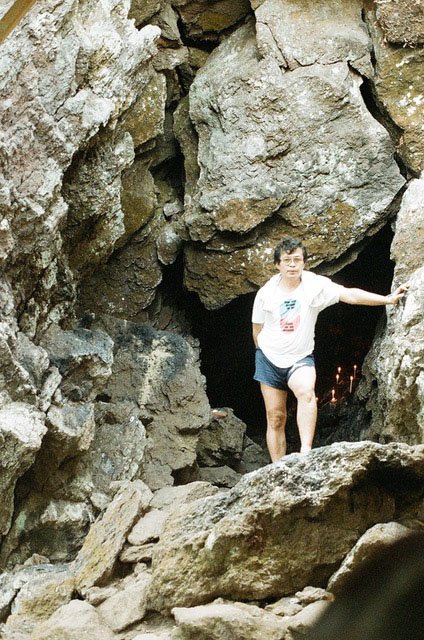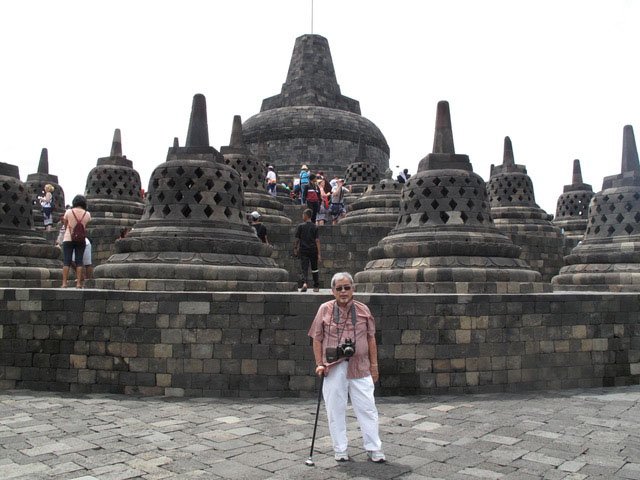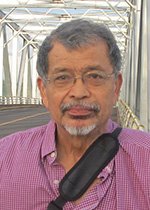Pilgrimages
/Temple in the Rock, Myanmar
A temple in Angkor Wat, Siem Reap, Cambodia. Note the yellow umbrella. (Photo by Rene Navarro)
Outside the Batu Caves in Kuala Lumpur, Malaysia. That’s the Lord Shiva Nataraja, Lord of the Dance. The pilgrim walks up the 294 steps and there’s a depiction of Him in an art work inside the cave. (Photo by Rene Navarro)
Lord Shiva Nataraja inside the Batu Caves (Photo by Rene Navarro)
In one of the stations on the pilgrimage to Mount Banahaw. (Photo courtesy of Rene Navarro)
Early morning Qigong in Machu Picchu, Peru, 2014 (Photo courtesy of Rene Navarro)
I am not a good travel writer. I do not bother to point out ordinary places no matter how attractive, or give directions to tourist spots. I am more interested in places of pilgrimage where I could feel a special energy, discover the divine presence, find an insight into myself or my life, or have an extraordinary experience that will transform me. There are many such places in the world.
But it requires a special kind of listening, patience and curiosity to “connect” to the special energy of a place. Perhaps, if you’ve done meditation, Tai chi chuan or an art like painting or poetry, or you have a religious calling, or love history, you’d be able to feel the frequency or vibration; or if you have the ability to keep quiet and allow the atmosphere to enter, you may be able to access the “heart” of the place. You have to leave most everything behind and be open to a new experience. In the phraseology of Zen, you have to empty your cup to get it filled. That is a precondition almost of how you build an energetic relationship with the place.
Often you have a background knowledge of the place you are going to because you have read about it in your research. But it could also be that you do not know where you are going because a guide has it all planned for you. This is what sometimes happens when only an outline of the tour is provided. It has happened to me more than once. On a trip to Myanmar, my companion and I were picked up from the hotel by car and were taken to a boat. We did not know where we were going. After an hour, we arrived at our destination. We walked to an old temple built into a cliff. It had a small, bare altar inside, hardly big enough to accommodate ten people. There were two monks. And then the guide took us for a walk to a white temple. We had the same kind of experience when we were in Laos: a guide took us from the hotel, put us on a boat on the Mekong, and after two hours, we clambered up a ladder to the Temple of 10,000 Buddhas.
The White Temple in Mingun, Myanmar (Photo by Rene Navarro)
In other counties it was different. We had no guide to lead us. During a pilgrimage to Delphi I took my two granddaughters, Ava and Isabel, with me. They were a great help with navigating the mountain. My primary doctor allowed me to join the Mediterranean tour although several tests showed I had symptoms of a heart condition and a cardiac procedure was considered a possibility. I let Isabel and Ava go ahead of me when I reached the plateau. I sat down and did my qigong overlooking a breath-taking landscape. It was Summer Solstice, June 21, and there were women in white tunics chanting probably in honor of Gaea, the Goddess who was the original Oracle before, as in many other places, the patriarchy installed a man – in this case Apollo -- in her place.
Sometimes the destination is not the place but a master. This was true in my visits to Bali, Java and Huangshan. I was with my friend and teacher David Verdesi; we went to see “King” (I do not like to disclose his name to preserve his privacy) and a 93-year-old Hindu priest famous for his ability to change into a monkey right before your eyes. King gave us a rather strange initiation – passing a red-hot chisel on our tongues. It was a cleansing and kundalini ritual. Another master David took me to was the Magus of Java, the legendary John Chang who could project electricity from his body. And, of course, we went to Huangshan to meet with GM Xuan Kong and Feng shifu, both wonderful healers with powerful energy and generous spirits. Important to remember: Whenever you meet a master, you must be humble and sincere. The master invariably can “read” your energy at first sight and it’s possible you’ll be ignored or told to return in five years.
in Borobudur, Java, Indonesia in 2016. It was high noon in the summer and it was difficult for me to navigate the ritual circumnavigation of the temple. My guide told me, 108 clockwise and 108 counterclockwise. I barely managed one. (Photo courtesy of Rene Navarro)
One time at the Abbey in Glastonbury, I actually had what may be called an OBE (Out of Body Experience). While meditating at the altar in the ruins of the old chapel, I found myself in the same place several centuries before. I saw soldiers killing priests and nuns while children cried. I woke up when I heard somebody announcing, “We are closing.” I realized I had been dreaming for the last two hours. When I got back to the house where I was staying I read in a book that indeed nuns and priests were massacred by the soldiers of the King.
I’ve done my meditation rituals or, when possible, Tai chi chuan in different places: Avebury (an even larger and more extensive stone circle than Stonehenge), the Temple of Karnak (where Jesus spent some years studying with the priests), several places in Scotland, and Besakih (Mother Temple) on the slope of the volcano Mount Agung in Bali.
Meditating In a stone circle in Scotland 2002 (Photo courtesy of Rene Navarro)
It is difficult to explain the experience that is spiritual and mystical. There is a kind of transfiguration, a heightened sense of wonder, a departure from the ordinary and mundane. You leave the place transformed and you are aware of the possibilities of life and travel. This experience is totally different from mere tourist travel. In the latter you are just a casual visitor, you see things – however beautiful or impressive – but they do not affect you in a deep sense; you are not transformed emotionally and psychically; you do not establish a profound relationship with the place or the person you are seeing.
When I walked up the Tor in Glastonbury, I felt myself on some kind of initiation, walking along not just a path but a Path. Step by step, I was being suffused with the energy of the place and its history. I was actually moving into the past or the mystical, beyond the geography or the location, into the mystery.
That is the apotheosis of a pilgrimage. Your soul is touched, and you are not the same again.
Author at Glastonbury Tor, 2002
Rene J. Navarro is a licensed acupuncturist, teacher of Classical Yang Family Tai chi chuan fist and weapons forms, Chi Nei Tsang organ massage, neidan/internal alchemy, and Daoist Yang-Sheng (Nourishing Life) regimen. He is a published poet and essayist.
More articles from Rene J. Navarro













